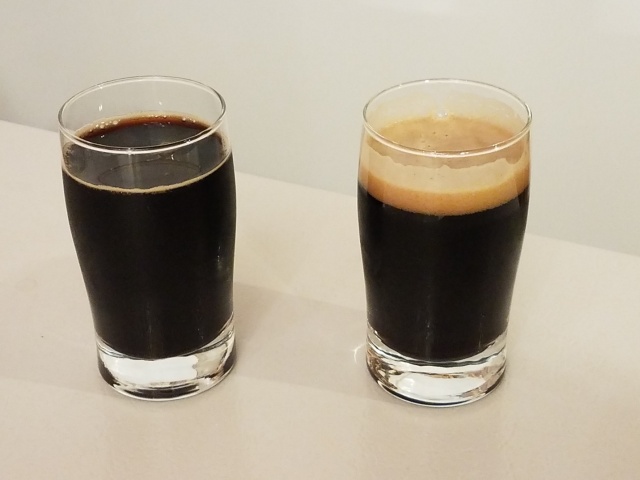This post is one in a series following six brewers collaborating to each make a small adjustment to a single recipe in order to improve it, then pass it along to the next brewer. We hope to learn more about the art of recipe creation as we see how other brewers approach the same recipe. The rest of the comparison tastings for this series can be found here.
The recipes for the beers being compared below are as follows:
| Iteration 9 | Iteration 10 | |
| Base Malt 2-row | 68% | 60.8% |
| Specialty Malt 1 | 10.2% Victory | 10.6% Victory |
| Specialty Malt 2 | 7.5% Roasted Barley | 7.8% Roasted Barley |
| Specialty Malt 3 | 1.7% Chocolate Malt | 1.8% Chocolate Malt |
| Specialty Malt 4 | 7.5% Flaked Barley | 7.8% Flaked Barley |
| Specialty Malt 5 | 5.1% Pale Chocolate | 5.3% Pale Chocolate |
| Sugar | None | 6% Corn Sugar |
| 60 min. hop | Nugget: 43.2 IBUs | Nugget: 42.9 IBUs |
| 5 min. hop | Centennial: 6.7 IBUs | Centennial: 6.7 IBUs |
| Yeast | WYeast 1450 Denny’s Favorite 50 | WYeast 1450 Denny’s Favorite 50 |
| OG | 1.065 | 1.064 |
| FG | 1.023 | 1.018 |
| ABV | 5.5% | 6.1% |
Taster: M. Willis
Iteration 9 has an attractive medium-brown color to the head. The head is small, short-lived, and leaves almost no lacing on the glass at first pour. Iteration 10 has a long lasting medium-brown, thick head. The pronounced cap blankets the top of this beer and leaves beautiful lacing in this iteration. Iteration 9 is inky black in color and Iteration 10 is very similar.

Left: Iteration 9 | Right: Iteration 10
It’s been about 45 days since I first sampled Iteration 9. Not much has changed since the original tasting. Dark molasses, roasted coffee, and more pronounced molasses as the beer warms. From my recollection, this beer is less complex in aroma than the previous iterations I tasted, Iteration 3 and Iteration 4. Iteration 10 shows a large reduction in 9’s sweetness allowing the great stout flavors to stand out again.
Flavor follows the nose in both beers. The dark molasses is dominant in Iteration 9. I’ve previously experienced Denny’s Favorite 50 stalling and not finish attenuating, and it’s my opinion that this probably happened with Iteration 9. It’s sweet whereas Iteration 10 is balanced.
Mouthfeel on Iteration 9 hasn’t changed much since the original tasting 45 days ago. It’s medium-bodied with that sweet slickness that I associate with under-attenuated beers. Time in a cold bottle didn’t fix that and wasn’t expected. Iteration 10 is simultaneously dry and creamy with all that flaked barley. That stickiness that laces the glass also coats the tongue, but without being cloying.

Left: Iteration 9 | Right: Iteration 10
The biggest differences to me were the mouthfeel and flavor of the beers. I definitely like the improvement from the sugar and felt this beer benefited from this change. Most of us have had what we thought was an under-attenuated beer and wondered what to fix. I’m glad I had a chance to test this out. This was very fun and informative to make this one change—and I believe it was successful.
Taster: C. McKenzie
Both iterations of this stout poured black with a tan head. Iteration 9 had a slightly larger head than 10 (which admittedly could have been a function of my pour). Both beers showed good head retention, and when the head did drop, a thin layer of foam was still present.

Iteration 9 smelled of coffee grounds, dark chocolate (or baker’s chocolate), and a hint of toast. Iteration 10 had an aroma of toast, coffee, and milk chocolate. There was also a hint of floral in the nose. Overall, Iteration 10 had a bigger aroma than 9.
The first flavor that struck me when I tasted Iteration 9 was cherry. This was followed by the taste of milk chocolate/chocolate bar and a touch of toast. The sweet chocolate flavor was the most prominent flavor. Iteration 10 tasted like biting into a milk chocolate covered espresso bean. There was a big chocolate bar component to this flavor. Lesser notes that I perceived included toast, floral, and citrus.
The takeaway for me from this comparison is that Iteration 10 ended up being all-around “more than.” Mostly, the same flavors were present with a couple extra shining through from the hops, but they all seemed to be present in a bigger way. All in all, the choice to add sugar to the grist would not have been a choice I would have personally made for a stout, but it turned out to be a solid choice. This is exactly what this collaborative project is all about—seeing how a choice you might never personally make for a recipe impacts the beer. Prompting this yeast to attenuate a bit lower than it would have otherwise (or ensuring it attenuated to the desired level) seemed to help all the flavors in this beer shine through more than they did previously.
